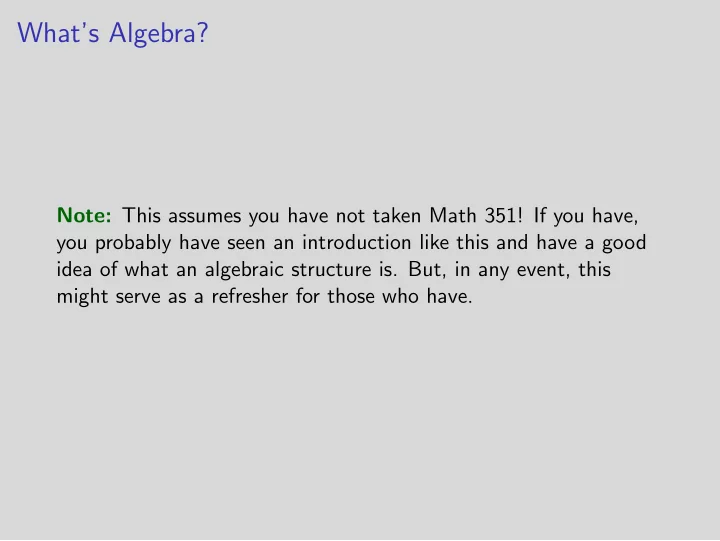

What’s Algebra? Note: This assumes you have not taken Math 351! If you have, you probably have seen an introduction like this and have a good idea of what an algebraic structure is. But, in any event, this might serve as a refresher for those who have.
What’s Algebra? Most basic: solving equations! x = b ax = b ⇒ if a � = 0! a , So, by using variables instead of specific numbers, we know how to √ solve many equations. [E.g., 2 x = 3, 5 x = − 4, ( 2 − 1) x = π e , etc.] In fact, we can go even further, and imagine a , b and x are [square] matrices instead of numbers. [Let’s switch to capitals, as it’s usual for matrices.] X = A − 1 B , AX = B if A is invertible! ⇒ Note: X = BA − 1 is incorrect , as multiplication of matrices is not commutative . [I.e., AB � = BA in general.]
Algebra So, the main goal of algebra is to deal with many cases with a single stroke, rather then individually. One could even try to deal with both cases from the previous slide [numbers and matrices and equations of the form ax = b ] in a single stroke: x = a − 1 b , ax = b ⇒ if a is invertible. [What does it mean for a be invertible ?] You have seen one or two examples of more advanced algebra: ◮ Vector Spaces from Math 251/257. ◮ Fields from Math 300/307, depending on the instructor/textbook. [W. Wade’s notes, commonly used, introduce fields.]
(Real) Vector Spaces A non-empty set V with a sum and a scalar product is a (real) vector space if it satisfies the following conditions: 0. u + v ∈ V for all u , v ∈ V , and k u ∈ V for all u ∈ V and k ∈ R ; 1. u + v = v + u for all u , v ∈ V ; 2. ( u + v ) + w = u + ( v + w ) for all u , v , w ∈ V ; 3. there is 0 ∈ V such that 0 + u = u for all u ∈ V ; 4. given u ∈ V , there exists − u ∈ V such that u + ( − u ) = 0 ; 5. k ( u + v ) = k u + k v for all u , v ∈ V and k ∈ R ; 6. ( k + l ) u = k u + l u for all u ∈ V and k , l ∈ R ; 7. k ( l u ) = ( kl ) u for all u ∈ V and k , l ∈ R ; 8. 1 u = u for all u ∈ V .
Examples of Vector Spaces Examples of Vector Spaces: ◮ R n ◮ M m , n ( R ) ( m × n matrices) with real entries ◮ R [ X ] (polynomials on the variable X and real coefficients) ◮ polynomials of R [ X ] with degree at most n ◮ continuous [or differentiable, or smooth] functions from R [or an interval] to R ◮ functions from a [fixed] set S to any [fixed] vector space V For general vector spaces, the coefficients/entries do not necessarily have to be in R , but have to be in some field . As we shall see later, Q and C are also fields, one can use those sets for the coefficients.
An Algebra Theorem Theorem For any vector space V and v ∈ V , we have that 0 · v = 0 . Proof: ◮ 0 · v = (0 + 0) · v [property of real numbers] ◮ 0 · v = 0 · v + 0 · v [property 5 of vec. sp.] ◮ 0 · v + − (0 · v ) = (0 · v + 0 · v ) + − (0 · v ) [property 4 of vec. sp.] ◮ 0 = 0 · v + (0 · v + − (0 · v )) [properties 4 and 2 of vec. sp.] ◮ 0 = 0 · v + 0 [property 4 of vec. sp.] ◮ 0 = 0 · v [property 3 of vec. sp.]
Algebra Now, we know that result above holds for all vectors spaces! [No need to check individually.] This works, of course, because in the proof we only used properties that are common to all vector spaces. This example is very typical of is done in abstract algebra, and we will do this same sort of thing many times through out the semester!
Recommend
More recommend